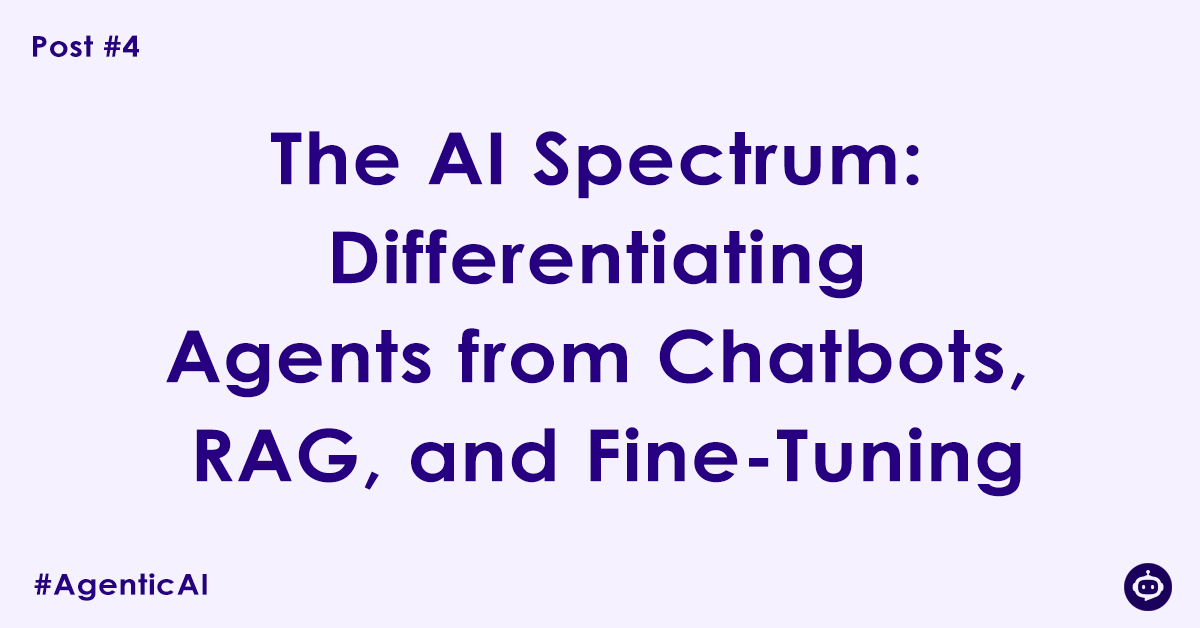The world of Artificial Intelligence is expanding at a breakneck pace, and with it, a vocabulary that can often seem bewildering. Terms like chatbots, RAG, fine-tuning, and AI agents are frequently used, sometimes interchangeably, leading to confusion about what each technology truly represents. To navigate this landscape, it’s crucial to understand the distinct roles and capabilities of each.
This post will demystify these common AI concepts, clarifying their differences and showing where AI agents fit within this broader technological spectrum.
The Foundation: Large Language Models (LLMs)
Before we dive into the specifics, it’s important to recognize that all these technologies are often built upon the same foundation: Large Language Models (LLMs). Think of an LLM, like GPT-4, as a highly knowledgeable and versatile engine for understanding and generating human-like text. The differences between chatbots, RAG, fine-tuning, and agents lie in how they leverage this engine.
1. Chatbots: The Conversationalists
At its most basic level, a chatbot is an AI designed to simulate human conversation. Early chatbots were heavily scripted, following predefined conversational flows. Today’s more advanced chatbots use LLMs to understand and respond to a wide range of user queries in a more natural and flexible manner.
- Primary Function: To converse with a user, answer questions, and provide information based on its training data.
- Key Characteristic: Reactive. A chatbot primarily waits for user input and then generates a response. It doesn’t typically take actions outside of the conversation.
- Analogy: A knowledgeable customer service representative who can answer any question based on the company’s training manual.
Diagram: The Basic Chatbot
+-------------------+
| User |
| (Asks a question) |
+-------------------+
|
v
+------------------+
| Chatbot |
| (Uses LLM to |
| generate answer) |
+------------------+
|
v
+------------------+
| User |
| (Receives answer)|
+------------------+2. Fine-Tuning: The Specialist
Fine-tuning is the process of taking a pre-trained LLM and further training it on a smaller, specific dataset. This process adapts the model to excel at a particular task or to adopt a specific tone or style.
- Primary Function: To specialize an LLM’s knowledge or behavior.
- Key Characteristic: A modification of the core model. The outcome is a new, specialized version of the original LLM.
- Analogy: A general practitioner (the pre-trained LLM) who undergoes additional training to become a cardiologist (the fine-tuned model). They have a deeper understanding of a specific domain.
Diagram: The Fine-Tuning Process
+---------------------+ +------------------------+ +------------------------+
| Pre-trained LLM | --> | Fine-Tuning on | --> | Specialized LLM |
| (General Knowledge) | | (Domain-Specific Data) | | (e.g., Medical Expert) |
+---------------------+ +------------------------+ +------------------------+3. Retrieval-Augmented Generation (RAG): The Open-Book Researcher
Retrieval-Augmented Generation (RAG) is a technique that enhances an LLM by connecting it to an external knowledge base. When a user asks a question, the RAG system first retrieves relevant information from this external source and then uses that information to generate a more accurate and contextually relevant answer.
- Primary Function: To ground an LLM’s responses in real-time, specific, or proprietary information, reducing the chances of “hallucinations” or outdated answers.
- Key Characteristic: Dynamic information access. It doesn’t change the LLM itself but provides it with up-to-date context for each query.
- Analogy: A student taking an open-book exam. They have their general knowledge (the LLM) but can also consult a textbook (the external knowledge base) to ensure their answer is precise and factual.
Diagram: The RAG Workflow
+-------------------+
| User |
| (Asks a question) |
+-------------------+
|
v
+------------------------+ +---------------------+
| External Knowledge Base|<-| RAG System Retrieves|
| (e.g., Company Docs) | | Relevant Information|
+------------------------+ +---------------------+
| (Provides context to LLM)
v
+--------------------+
| LLM |
| (Generates answer |
| with new context) |
+--------------------+
|
v
+------------------+
| User |
| (Receives answer)|
+------------------+4. AI Agents: The Autonomous Doers
This brings us to AI Agents. An agent is a more sophisticated system that uses an LLM as its “brain” to not only understand and reason but also to plan, make decisions, and take actions to achieve a specific goal. An agent can often use other tools, including RAG, to accomplish its objectives.
- Primary Function: To autonomously execute tasks and achieve goals.
- Key Characteristic: Proactive and goal-oriented. An agent can break down a complex request into smaller steps, decide which tools to use for each step, and execute those steps in a logical sequence.
- Analogy: A project manager. You give them a high-level objective (e.g., “organize a team offsite”), and they independently handle all the sub-tasks: researching venues, checking calendars, booking flights, and sending out invitations.
Diagram: The AI Agent in Action
+------------------+
| User |
| (Gives a goal) |
+------------------+
|
v
+------------------+
| AI Agent |
| (Plans & Reasons)|
+------------------+
/ | \
/ | \
v v v
+----------+ +----------+ +-----------+
| Tool 1 | | Tool 2 | | Tool 3 |
| (e.g., | | (e.g., | | (e.g., Web|
| RAG) | | Calendar)| | Search) |
+----------+ +----------+ +-----------+
\ | /
\ | /
v v v
+------------------+
| AI Agent |
| (Executes tasks &|
| completes goal) |
+------------------+The Spectrum of AI Interaction
Here’s a simplified way to visualize where these technologies fit on a spectrum of autonomy and capability:
[Simple] <————————————————> [Complex & Autonomous]
Chatbot >> Fine-Tuned Model >> RAG System >> AI Agent
(Converses) (Specializes) (Researches) (Acts & Achieves)
In conclusion, while chatbots, fine-tuning, and RAG are all powerful AI technologies, they are distinct in their purpose and function. An AI agent represents a significant leap forward, moving from passive conversation and information retrieval to active, goal-oriented problem-solving. Understanding these differences is key to appreciating the unique power and promise of the agentic AI paradigm.
Author

Experienced Cloud & DevOps Engineer with hands-on experience in AWS, GCP, Terraform, Ansible, ELK, Docker, Git, GitLab, Python, PowerShell, Shell, and theoretical knowledge on Azure, Kubernetes & Jenkins. In my free time, I write blogs on ckdbtech.com
